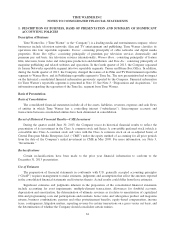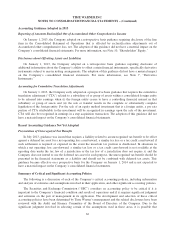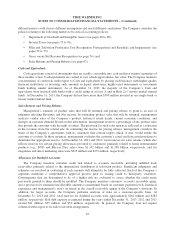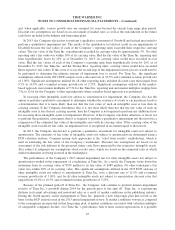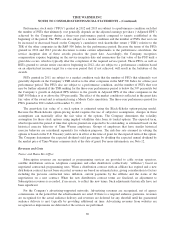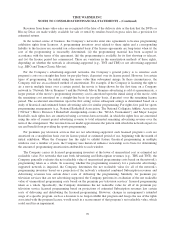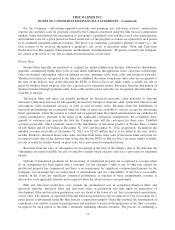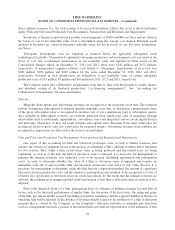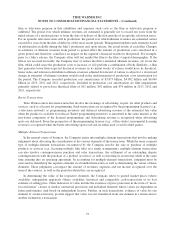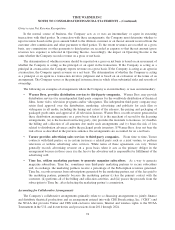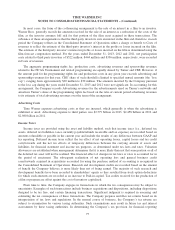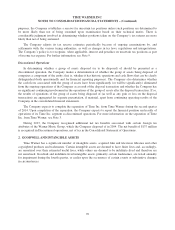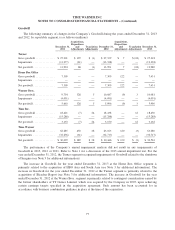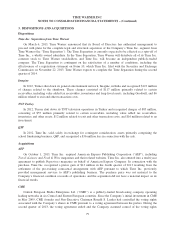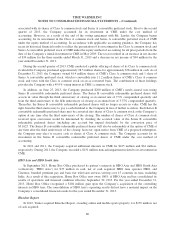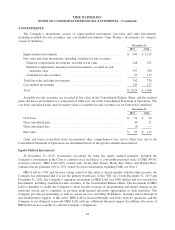Time Magazine 2013 Annual Report Download - page 87
Download and view the complete annual report
Please find page 87 of the 2013 Time Magazine annual report below. You can navigate through the pages in the report by either clicking on the pages listed below, or by using the keyword search tool below to find specific information within the annual report.TIME WARNER INC.
NOTES TO CONSOLIDATED FINANCIAL STATEMENTS – (Continued)
For the Company’s advertising-supported networks and premium pay television services, amortization
expense also includes costs for programs owned by the Company amortized using the film forecast computation
method. Under this method, the amortization of a program’s capitalized costs and the accrual of its participations
and residuals costs for a given period are based on the ratio of the program’s revenues recognized for such period
to its estimated remaining ultimate revenues. The process of estimating a program’s ultimate revenues (i.e., the
total revenue to be received throughout a program’s life cycle) is discussed under “Film and Television
Production Cost Recognition, Participations and Residuals and Impairments.” Programs owned by the Company
are carried at the lower of cost, less accumulated amortization, or fair value.
Warner Bros.
Feature films typically are produced or acquired for initial exhibition in theaters, followed by distribution,
generally commencing within three years of such initial exhibition, through home video, electronic sell-through,
video-on-demand, subscription video-on-demand services, premium cable, basic cable and broadcast networks.
Theatrical revenues are recognized as the films are exhibited. Revenues from home video sales are recognized at
the later of the delivery date or the date that the DVDs or Blu-ray Discs are made widely available for sale or
rental by retailers based on gross sales less a provision for estimated returns. Revenues from the distribution of
theatrical product through premium cable, basic cable and broadcast networks are recognized when the films are
available to telecast.
Television films and series are initially produced for broadcast networks, cable networks or first-run
television syndication and may be subsequently licensed for foreign or domestic cable, syndicated television and
subscription video-on-demand services, as well as sold on home video. Revenues from the distribution of
television programming are recognized when the films or series are available to telecast, except for advertising
barter agreements, where the revenue is valued and recognized when the related advertisements are exhibited. In
certain circumstances, pursuant to the terms of the applicable contractual arrangements, the availability dates
granted to customers may precede the date the Company may bill the customers for these sales. Unbilled
accounts receivable, which primarily relate to the distribution of television product at Warner Bros., totaled
$3.418 billion and $3.210 billion at December 31, 2013 and December 31, 2012, respectively. Included in the
unbilled accounts receivable at December 31, 2013 was $2.073 billion that is to be billed in the next twelve
months. Similar to theatrical home video sales, revenues from home video sales of television films and series are
recognized at the later of the delivery date or the date that the DVDs or Blu-ray Discs are made widely available
for sale or rental by retailers based on gross sales less a provision for estimated returns.
Revenues from the sales of videogames are recognized at the later of the delivery date or the date that the
videogames are made available for sale or rental by retailers based on gross sales less a provision for estimated
returns.
Upfront or guaranteed payments for the licensing of intellectual property are recognized as revenue when
(i) an arrangement has been signed with a customer, (ii) the customer’s right to use or otherwise exploit the
intellectual property has commenced and there is no requirement for significant continued performance by the
Company, (iii) licensing fees are either fixed or determinable and (iv) collectability of the fees is reasonably
assured. In the event any significant continued performance is required in these arrangements, revenue is
allocated to each applicable element and recognized when the related services are performed.
Film and television production costs include the unamortized cost of completed theatrical films and
television episodes, theatrical films and television series in production and film rights in preparation of
development. Film and television production costs are stated at the lower of cost, less accumulated amortization,
or fair value. The amount of capitalized film and television production costs recognized as Cost of revenues for a
given period is determined using the film forecast computation method. Under this method, the amortization of
capitalized costs and the accrual of participations and residuals is based on the proportion of the film’s revenues
recognized for such period to the film’s estimated remaining ultimate revenues. The process of estimating a
71


